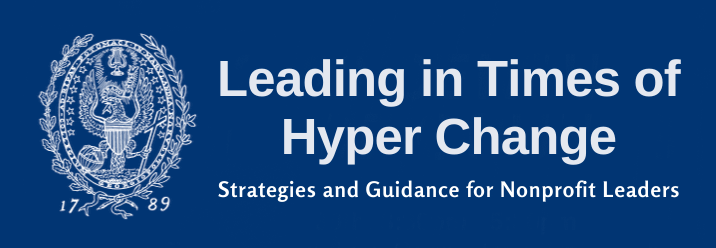The Role of the Board During Hyper Change

Posted in News Story
By Michela Perrone, Ph.D.
March 31, 2020
Michela M. Perrone is President of MMP Associates, which supports the development and increased effectiveness of nonprofit organizations, boards and CEOs. She is also part of the Center for Public & Nonprofit Leadership faculty.
The nonprofit sector is being hit hard by the impact of the coronavirus on our country and world. The capacity to serve people in need is stretched to the limit. Donations are dwindling. Staff working from home are less able to provide the in-person support that is needed by their clients, while safe distance is impossible to keep in soup kitchens and shelters.
The mainstream media has paid scant attention to the role and needs of nonprofits. Aside from a very thoughtful blog post on the BoardSource website, there has been little guidance about the role of nonprofit boards during this pandemic.
And yet, boards play an essential role in supporting nonprofit sector work across the globe.
A recent survey of nonprofits organizations in the Washington Region, conducted by the Center for Nonprofit Advancement, has revealed the following greatest needs:
- Effective remote communication mechanisms and structures
- Funding for video conferencing and other remote communication tools
- Training on how to manage staff working remotely
- Advice on how to manage crisis
So, how could boards respond to these needs and others in order to support their organization appropriately and effectively during these difficult times?
Here are some recommendations:
- Express often, in writing and verbally, the board support of the executive and the staff.
- Empathize with the staff in addressing the dramatic life changes we are all being forced to make.
- Be positive and comforting in approach and communication: we will make it through this together!
- Develop a simple and clear process of communication with the executive and the staff. Staying in touch with the executive once a week would be wise. A shared decision between the board and the executive as to when and how to communicate with the entire staff should guide that protocol.
- Clarify the difference in the roles of board members and staff in dealing with the media and the public.
- Clarify the difference in roles of board members and staff in making decisions about organizational protocols in response to the pandemic. Trust the staff and their access to professional networks for their advice and counsel.
- Move promptly with the decisions the executive is asking the board to make. Given how quickly the environment is changing, a 48 hours or less response may be necessary.
- When it is safe, volunteer to help with meeting the needs of the organization.
- Do not micromanage decisions or actions that belong to the executive: oversight is not interference. (See list of board roles below)
- Most important now in guiding the board and executive relationship are open and honest communication, trust and respect in each other as persons and in their roles, cooperative planning, and evaluation and transparent sharing of mutual expectations
- Use your financial reserves as the executive advises. They were there for rainy days. These are the rainy days.
The Role of the Board in Supporting the CEO/ED
Communication
- Coordinates its communication to the staff through the CEO/ED to avoid confusion and conflicts.
- Announces board policy changes to the CEO/ED prior to communicating them to the public.
- Promptly discusses issues of concern to the board with the CEO and does not act on them alone.
- Coordinates its communication to the public and the organization’s constituency through the ED or his/her designees in order to ensure a consistent and coherent message.
Relationship Building
- Assesses the performance of the CEO in a fair and inclusive manner, per the pre-established evaluation plan.
- Leads the regular process of evaluating the effectiveness of the organization, per the pre-established evaluation plan.
- Maintains a strong, open relationship with the ED and helps him/her do the job effectively.
Executive Director and Organizational Support
- Understands its governance role and acts accordingly, providing support when requested by the CEO/ED and staff.
- Understands and respects the workload of the staff when requesting support on board activities.
- Is respectful and acts professionally in regards to the CEO and staff—returns phone calls; meets deadlines; and gives adequate notice of meetings and special requests to the ED/staff.
- Supports the organization in the community, acting as an ambassador for the organization.
Additional articles in this series, Leading in Times of Hyper Change, can be found on our website, Facebook and Twitter.
